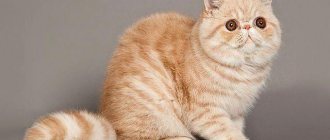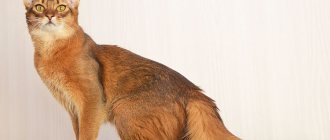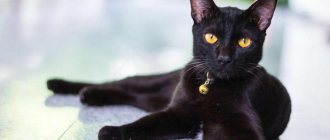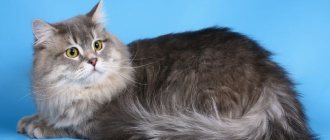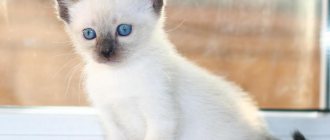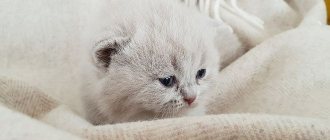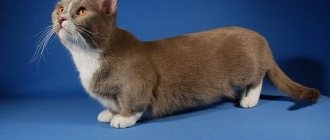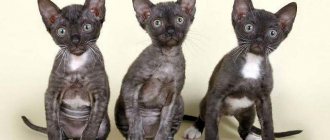Brief history of the breed
The ancestors of the European or Celtic shorthaired breed were ordinary yard cats that lived side by side with humans in Northern Europe since the times of Ancient Rome.
Basically, people valued them for their hunting qualities - the animals exterminated rats and mice.
During the dark period of the Middle Ages, the number of cats decreased noticeably due to the efforts of the Inquisition. All black animals were declared accomplices of the devil and sent to the stake.
Over time, the population size recovered, and by the middle of the 19th century, first amateur breeders and then specialists paid attention to the characteristic animals. By the end of the century, the European cat was presented at exhibitions, but it did not receive official recognition as a breed.
At the beginning of the 20th century, felinologists in Denmark, Norway and Sweden seriously began breeding the breed. In 1946, Swedish breeders first registered the domestic cat. Later it received the name European Shorthair. The American line of selection also stood out separately.
Subsequently, the selection principles of British, American and Scandinavian felinologists diverged. To avoid confusion, the World Cat Federation has registered the Scandinavian breed as the "Celtic Shorthair". This includes animals that live in a specific area and meet fixed standards.
Thus, both names of the breed ─ European and Celtic Shorthair ─ are correct and equivalent.
Description of the European cat
The noble representatives of European cats are not popular enough; they can rarely be seen at various exhibitions. This was influenced by their resemblance to street cats. True European cats differ from strays in appearance and behavior.
The European Shorthair is not in such demand as, for example, Maine Coons
One version says that the European breed came from Rome along with soldiers. Another is that she sailed from France on a ship on which she protected food from rodents. But not as important as the result - tabby cats spread throughout Europe. But their numbers decreased significantly thanks to the activities of church ministers, who saw the devil’s helpers in the affectionate cats.
Small settlements kept the cats, and the population soon recovered. Then the breeders got to work. They singled out the best qualities of European cats and collected a common breed, creating strong, intelligent, picky animals that still delight their owners.
The result was presented at a cat exhibition in Berlin (1938). The pet was demonstrated as a representative of a new breed and as the strongest hunter. In many ways, European cats were similar to the shorthaired “British”. For many years they were competitors at shows, but now they have been displaced by other species of baleen.
European shorthair or smooth-haired cat
The coloring is close to natural colors, various specks of other shades are possible.
For your information! This breed is very similar to the “British”, but it is not so massive, and they are also distinguished by their wool. It is thinner, more elastic, smooth and shiny and fits tightly to the body. British cats develop a fluffy coat.
European longhair cat
The fur of kittens from two “Europeans” may be long, dense and thick. This is one of the rare features of crossing these cats. The kittens are quite beautiful, playful and have silky, shiny and iridescent fur. Therefore, owners of “Europeans” should not worry that the kitten turned out to be not purebred.
Celtic cat
The Celtic cat is slightly smaller in size, this has become the most important feature in the popularity of the breed. She has a strong, collected body with dense and short hair. In appearance, this is an ordinary domestic cat with strong paws of normal length and a thick, rounded tail. The ears are ordinary: wide at the base and tapering towards the tips.
The color can be different: dark, red, bluish, tortoiseshell, etc. Celtic cats are quiet pets; owners will rarely hear loud meows from them. Many see this as positive.
Eastern European cat
These medium-sized to large pets are not short-legged, but strong and hardy. The chest is large and well developed. The paws are medium and slightly rounded. The tail reaches a standard length, it is wider near the base, gradually narrows and is slightly rounded towards the end.
Note! Eye color is most often green, yellow, orange or blue and depends on the pet's coat.
Swedish cat
In 1946, breeders in Sweden registered the Swedish domestic cat, which later joined the class of European shorthairs.
Interestingly, the description of the European individual was the same as that of the “British”. Only in the 80s. it was identified as an independent breed.
Interesting Facts
Fans of purring creatures will be interested in the following information:
- It is surprising that the oldest breed in the world, the European Aboriginal, is also the youngest. It received its official name ─ “European or Celtic shorthair cat” in 1982;
- There is another variety of European cat - longhaired. This is a relative of the elegant “Celt” - a Siberian breed popular in Russia. It is widespread both in the Eastern European part of the continent and beyond the Urals;
- The Celtic Shorthair is more of a companion than a relative. This is her character, free and independent;
- On the scale of temperament, Celtic Shorthairs occupy the golden mean: affectionate without intrusiveness and leaders in spirit, but not aggressive.
Breed description, standards, appearance
Ideally, the standards for Celtic longhair cats include the absence of admixtures from other breeding lines. Working on the main characteristics of the European breed, breeders tried to consolidate the following features:
- unsurpassed trapping and hunting qualities;
- equanimity, stress resistance;
- attachment to home; I had to work hard on this quality, because the Celts are prone to vagrancy.
Dimensions and weight
Celtic cats are distinguished from other breeds by their pronounced sexual dimorphism. Females and males are very different from each other.
The Celtic cat breed ranges in size from medium to large. The girls are gracefully built, their standard weight is about 4 kg. European shorthair cats have a more powerful build, their weight is up to 8 kg.
Anatomical characteristics
Main characteristics in the description of the Celtic breed:
- the body is flexible, muscular, “high-slung”, with a straight back;
- developed, convex chest;
- strong limbs of medium length, tapering downwards, paws rounded;
- large head with pronounced cheeks, the transition from forehead to nose, large chin stand out in profile;
- The tail, wide at the base, tapers and rounds towards the tip;
- ears in the shape of an isosceles triangle, the distance between them is equal to the width of the ear. Tassels at the tips are acceptable, vertical fit;
- the eyes are slightly slanted and rounded. Their color should match the coat color. They are often green, blue, honey-amber. Heterochromia (eyes of different colors) is allowed.
Color and coat type
Representatives of the Celtic line have a dense, thick and short coat. The slightly pronounced undercoat determines its adherence to the body, elasticity and noble shine.
The standard includes more than 50 types of colors in natural shades. Range - from white to black. Some breeders of the European branch give preference to one particular rare color. They make it their trademark.
The most valuable are white European cats and tabby-colored animals: silver, golden, marbled.
Possible breed defects
Flaws that deviate from the standards of the European or Celtic Shorthair cat breed include:
- too wide muzzle ─ this is a sign of the British line of selection;
- visible signs of admixtures of other breeds;
- creases along the length of the tail, the presence of a tassel on it;
- white spots in the color: only the main background can be of this color;
- saggy cheeks.
Also, if all the standard external characteristics are present, the following colors are considered unacceptable in the Celtic line:
- faun (lightened beige);
- chocolate;
- Siamese;
- red or brown-red;
- lilac.
History of the origin of the European Shorthair
global $ads_google;
//data-ad-slot=”2475549904″ $ads_google = empty($ads_google) ? false : true; ?> if ($ads_google == false) {?> $ads_google = true; ?> } ?> How harmonious and beautiful it is to take a gift from nature and, with the help of some intervention, improve it, turning it into a wonderful purring creature. In these lines you can see a brief history of the origin of the European shorthair cat, whose ancestors lived freely in most of the northern territories of Europe.
The genes of aboriginal cats turned out to be strong and were easily passed on from generation to generation, which resulted in a specific type of appearance and temperament.
Breeders paid attention to the animal, but since the approaches were different, the appearance of the bred breeds was somewhat different from each other, and the names were different.
So there is no special legend in the origin of seals: the whole of Europe can safely be considered the animal’s homeland. The first time a European (Celtic) cat appeared at an exhibition was in 1938, but a similar cat was registered as a representative of the breed only in 1948, and then as a variety of the British one. The new breed received official status only in 1981.
Character and temperament
The European Shorthair cat is intelligent and independent. She is calm and has self-esteem.
Having appeared in the house, the Celtic handsome man chooses a leader, a leader from among the family members. The owner becomes the idol of the European cat: the pet takes on the character, habits and temperament of the owner.
The animal easily adapts to the regime and conditions in the family, is emotionally involved in the relationship, but is not imposed. The short-haired pet tolerates loneliness well, does not get bored without company, and knows how to keep itself busy. Pets of the European breed are ideal for people who spend a lot of time at work.
Possessing a keen sense of territory, the Shorthaired Celt will not tolerate a competitor near him. Therefore, you should not buy another purr or puppy for a house where a cat of the European breed already lives.
Smaller animals: birds, hamsters or rats ─ should also be kept away, and it is better not to be kept in the same house as a Celtic cat. Her innate instinct as a predatory mousetrap will leave them no chance.
Despite such a harsh disposition, European Shorthair cats are sociable, playful and inquisitive. They will be happy to play with the baby. When communicating with children, the Celtic cat shows remarkable patience. He will not respond to aggression, he will simply leave the offender.
This pet does not tolerate familiarity and prefers partnerships.
A valuable quality of European shorthair cats is their silence. They will not meow without a good reason.
Catering
The owner has the right to choose what he will feed his pet: natural food or prepared food. European shorthair cats do not require any specific nutrition and are not prone to overeating, which means that they are not at risk of obesity. But the owner should remember some rules.
Holistics
When choosing industrial food, take into account the individual needs of the pet, its physical characteristics: age, health, weight. Holistics are considered the best in quality. These foods use fresh and dehydrated meat, fish fillets, natural preservatives, berries, fruits and vegetables. In addition, it contains a good vitamin and mineral supplement. Examples: Acana, Wildcat, Pronature Holistic.
Super premium
Super premium food is in second place and differs from holistic food in the smaller amount of meat. However, the amount of meat, meat ingredients, vegetables and nutrients in general allows you to use these foods without fear. And they are cheaper than holistic feeds. Examples: Brooksfield, Guabi Natural, Arden Grange.
Premium and Economy
Premium and economy food are cheaper than those mentioned above, but they practically do not receive approval from cat owners. They most often contain meat waste (bones, skin and tripe, not meat), allergy-causing wheat and corn, vegetable proteins, antioxidants and preservatives of unknown origin. Premium food samples: Eukanuba, Night Hunter, Safari. Economy group foods include Whiskas, Puffins, Perfect Fit.
Below are recommended super-premium and holistic foods. Links with the names of the food are clickable, on them you can, within our website, get acquainted with the descriptions of the food and read reviews from owners of European Shorthair cats.
| Premium | Super premium | Holistic |
| Wahre Liebe | Natyka | Farmina N&D |
Care and maintenance
The main difference between the Celtic breed and others is its love for walks. European cats should be taken outside several times a week. They quickly get used to a harness and leash, and walks with their owner give them pleasure.
Otherwise, short-haired European purrs do not require any special conditions. Of course, the basic rules for caring for domestic cats will have to be followed:
- need to take care of the coat. To keep the coat of a European smooth-haired cat always shiny, it is enough to comb it with a special brush once a week, and during the molting period - every day;
- Regular care of ears, eyes and teeth is required, either on your own or with the help of a veterinarian;
- You need to trim your claws with special tweezers once a month. There must be a scratching post in the house;
- It is often impossible to bathe a Celtic Shorthair cat: this has a bad effect on the quality of the coat. One procedure every six months is enough;
- Vaccinations and antiparasitic measures should be carried out on time. The schedule of procedures will be drawn up by a veterinarian. The first vaccination is carried out on a kitten at the age of 2-3 months.
The European Shorthair cat, like any other cat, must have permanent places for feeding, toileting and resting. The bed should be placed away from heating devices, but not in a draft. The entire room should be visible from it. This will allow the European pet to feel safe.
Features of behavior
“Europeans” behave quite modestly; more often this behavior is observed when a stranger appears in the house. On the contrary, the pet behaves affectionately and friendly with its owner. Owners of European cats note that the pet is sanguine by nature - he loves to have fun with the owner at any time, but at the same time they are unobtrusive and do not require undue attention.
Advantages and disadvantages of the character of the European smooth-haired cat
The pet is indifferent to the guests of its owners; it does not ask to be held in their arms to be petted. This cat communicates with children as equals, hiding arrogance and aggression. Many cat owners notice the intellectual abilities of Celts and believe that they understand human language.
Despite its positive character, the Eastern European cat will not tolerate another pet in the house. As the leader of the home, this cat agrees to recognize only a person, well, or herself. Therefore, it is impossible for a Celtic cat to live together in the same house with other animals.
How to choose the right kitten
For a purebred Celtic Shorthair kitten, you should contact only special nurseries or trusted breeders.
The key to making the right choice is that the parents of the European baby have the appropriate documents about the breed ─ passports or certificates. They are transferred to the buyer upon sale.
You should pay attention to the appearance of the mother. There must be pronounced signs of the European Shorthair breed and compliance with the standards.
Typically, kittens are weaned from their mother and sold at 2.5 months. By this time, children are supposed to undergo anthelmintic treatment and vaccination and have a certificate about this from a veterinarian. The short-haired European animal must be litter trained and feed on its own.
The character of a two to three month old Celtic kitten is already clearly expressed. The future owner chooses a companion in accordance with his own temperament and needs.
Kitten care
No special skills are required in caring for a short-haired European baby. All he needs is attention and affection. At first, the new owner will have to replace the European kitten’s mother ─ kind, but strict.
It is immediately necessary to determine the place of feeding and toilet for the pet and ensure strict compliance with the rules.
At first, you will have to devote more time to your short-haired European baby, pick him up more often, and stroke his tummy so that there are no problems with stool.
Later, when the new tenant gets comfortable in the house, he will find something to do with himself. To keep your little Celtic European physically active, you can purchase several toys.
In general, caring for kittens is the same as for adult European purrs.
A short-haired Celtic baby should be fed frequently, in small portions, by chopping the food. Experienced breeders recommend leaving food overnight. Special food for kittens, dry and wet, is best suited for nutrition.
Your veterinarian will recommend vitamin supplements. Babies have a high metabolism, they quickly become hungry. After changing teeth, at 7-8 months of age, a European kitten can be switched to adult food.
Purchasing a European Shorthair kitten
Breeding this breed in Russia is hard and, unfortunately, often thankless work, since it is not always possible to find good owners for the kittens. A black or tortoiseshell European cat is sometimes considered not as a purebred cat, but as an ordinary domestic cat, hence the corresponding attitude towards it. In addition, some unscrupulous owners try by any means to pass off their kittens as representatives of the European Shorthair breed, although they are a crossbreed and in no way meet the standard of the International Federation. The ideal European should be free from the genetic influence of other breeds.
In Russia there are no nurseries engaged in breeding European Shorthairs - there are only private breeders. The cost of a kitten, compared to other breeds, is small: from two to fifteen thousand rubles, depending on the class of the baby and the number of titles his parents have. If you decide to purchase a kitten from a cattery abroad, its cost will be higher: from twenty-five to forty thousand rubles plus delivery costs.
It is better to purchase a kitten at the age of three months, as young animals adapt more quickly to new living conditions. Ideally, they find a breeder in advance, get acquainted with the mother of the future pet and the peculiarities of its maintenance, and clarify what type of food, tray and filler were used.
When completing a transaction, be very careful: the kitten must not only meet the breed standard, but also be a healthy and strong baby. External signs of the absence of diseases - clean eyes, ears, nose, anus; shiny and clean coat without combing or bald spots; neat claws without any breaks. The kitten should move well, be active and non-aggressive.
The breeder must provide you with a package of accompanying documents:
- contract of sale;
- the baby’s passport indicating his pedigree, name and date of birth;
- information about vaccination.
Kittens of this breed are popular abroad
Feeding the cat
The European Shorthair is unpretentious in nutrition, has a good appetite and is not susceptible to diseases of the gastrointestinal tract. She does not need to follow a special diet. If desired, the owner can choose one of two feeding options for the Celtic Shorthair cat:
- ready-made food, a wide range of which is presented in special departments of any supermarket. It's not too budget-friendly, but convenient;
- table made from natural products. It will take time to prepare, but it is accessible, healthy and inexpensive.
Natural food for the Celtic Shorthair includes:
- boiled or scalded meat and offal;
- vegetables (except legumes and eggplants);
- boiled fish;
- cereal porridges and soups;
- dairy products.
The natural diet of a European cat must be supplemented with vitamin and mineral complexes. You can buy them at veterinary pharmacies.
To avoid health problems for the short-haired purr, the following are strictly prohibited:
- all products from the master's table, especially smoked meats, sausages, fried, fatty and sweet foods;
- milk: some animals are lactose intolerant;
- raw fish: the risk of helminth infection is significant.
An adult European cat should be fed 2-3 times a day. Clean water must be available at all times.
Education and physical activity
Representatives of the European Shorthair breed are intelligent, smart and independent. In the process of raising and communicating with a Celtic cat, you need to be respectful and patient. The animal is well versed in the intonations of the human voice.
Demandingness and affection, perseverance and consistency will help in raising an obedient and equal family member. Screaming and rough handling will make a neurasthenic out of the Celtic Shorthair.
To prevent your cat from damaging the furniture, you need to purchase a scratching post. The European Shorthair should be provided with a place for outdoor games and climbing. It is necessary to remove all objects that could break from horizontal surfaces. Wires from electrical appliances are supposed to be hidden from the Celtic cat.
The ideal option would be to purchase a special complex for cats. Pet stores have a large selection of interactive toys. Having fun with them, a European shorthair cat can keep itself busy for a long time.
Sterilization and castration
If the owner of the Celtic beauty does not plan to regularly produce offspring, the animal should be sterilized (cat) or neutered (male). This can be done when the European pet reaches the age of 8-9 months. The time for the operation must be chosen correctly: females should not be in heat, and males should not be in heat.
There is no need to be afraid of interference. If it is performed by an experienced specialist under anesthesia, it will not cause harm.
It is much more dangerous to regularly suppress the sexual instinct with hormonal drugs. If used frequently, they can cause irreversible changes in the body of a European cat.
Tumor and cystic formations often occur in the abdominal cavity. In this case, complex surgical intervention cannot be avoided, and the postoperative period will be difficult.
Celtic cat health
The most wonderful information about the health of the European Shorthair should be considered the absence of genetic diseases. Simple cat diseases can be avoided if vaccinations are not skipped. Although the breed is healthy, no one has canceled vaccinations as an immune defense! This applies even to those cats that do not leave the house: people bring viruses and bacteria from the street on their clothes and shoes, this is quite enough to create a threat to the cat’s health.
Despite the vaccinations, there are a number of diseases that can undermine a pet’s health and even cause a high temperature. In this case, you should not ignore the advice of veterinarians.
Before the age of one year, pets of this breed that will not take part in breeding should be castrated or sterilized. It is worth finding out the difference between these operations and making a choice.
When a cat comes into third heat, you can send your pet for mating. Mating is arranged in the first two days of estrus with an experienced cat partner.
global $ads_google; //data-ad-slot=”2475549904″ $ads_google = empty($ads_google) ? false : true; ?> if ($ads_google == false) {?>
$ads_google = true; ?> } ?>
Pregnancy proceeds smoothly for an average of 65 days, and childbirth usually ends with the appearance of healthy offspring.
The life expectancy of pets is good and ranges from 15 to 17 years.
Pros and cons of the breed
Naturally, keeping any animal in the house introduces some inconveniences into the family’s usual way of life. But what are small everyday problems worth compared to the happiness of communicating with wonderful cats!
Of course, you need to choose a pet with open eyes, clearly understanding the pros and cons of a particular breed. The Celtic Shorthair cat has virtually no disadvantages.
| Advantages | Flaws |
| Good health, absence of genetically determined diseases | Sometimes too independent and stubborn |
| Does not require large material costs or special efforts to maintain | It may be difficult to acquire a purebred European smoothhair cat |
| Hardly suitable for show enthusiasts and breeders. | |
| The European cat breed is unpretentious in nutrition | The Celtic breed is not popular among domestic breeders |
| Good-natured disposition. Affectionate without intrusiveness | |
| Self-sufficient, independent | |
| Silent, rarely meow | |
| Loyal to their master |
The character of a Celtic cat is a reflection of the soul and temperament of its owner. Its peculiarity is the combination of incongruous things: devotion and independence, gentleness, accommodatingness and stubbornness. European purrs respond to affection and love in full reciprocity.
The cheerfulness of the Celtic Shorthair cat is captivating. Kind, smart, but at the same time crafty and independent, Celts are ideal for keeping in a family.
There is nothing exotic in the appearance of European shorthair cats. But they have lived next to a person for so many centuries that, looking into their eyes, you can see the Soul.
Health
European shorthair cats are characterized by good health and rarely get sick. Immunity to illnesses is inherent in them at the genetic level. One of the reasons is that to develop the breed it was not necessary to cross closely related individuals.
European shorthair cats are healthy
In addition, the animal’s body is resistant to infections. Despite this, the vaccination schedule should be followed, especially if the cat is free-range. Deworming is also mandatory, since parasites can enter the body even with food.
What to do if your cat has helminths

